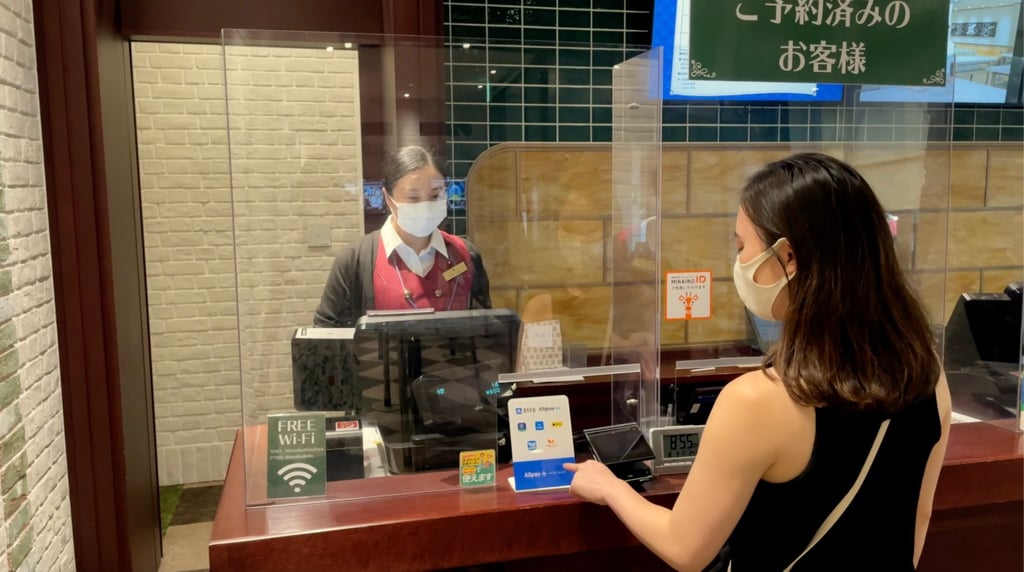How Alipay+, a cross-border payment solution, makes it easier to use existing e-wallets around the world

[Sponsored article]
As the world is emerging from the Covid-19 pandemic, global travel is picking up again. A survey of travel sentiment, carried out last month by the South China Morning Post and payment solution Alipay+, highlights just how useful such an innovative offering can be.
Nearly a quarter of the people questioned for the poll said they plan to take more than five overseas trips this year. Almost half of them expect to spend more than US$1,000 on retail, dining and entertainment on each overseas trip. Over a quarter said they want to keep using their existing electronic wallets for transactions while abroad because of brand trust.
People have wanted the ability to use their existing e-wallets while travelling overseas for a long time, but the effects of the coronavirus disease on our daily lives heightened that demand.
The Covid-19 pandemic has helped spark financial inclusion worldwide after forcing many industries to adapt and build digital products suited to a dramatically new way of life – one burdened by the challenges of physical isolation.
Lockdowns and social distancing saw cinemagoers, for example, opt for film streaming services, offices were closed while staff stayed connected from home via video conferences, and bricks-and mortar stores switched to selling their goods online.
Once business activity had moved online, financial services rapidly followed. Interest in financial technology (fintech) – the use of digital technologies to provide financial services – spiked after the onset of the pandemic, according to an October 2022 report, “Economic Resilience During the Covid-19 Pandemic”.
The report was published by the Centre for Sustainable Finance Innovation at Nanyang Technological University’s Nanyang Business School, in Singapore in collaboration with Ant Group. Owner of digital payment solution provider Alipay, Ant Group is an affiliate company of Alibaba Group Holding, the Chinese conglomerate which owns the South China Morning Post.

A study of Google-search trends showed that from 2019 to 2020 there was a large increase in online search volumes of various fintech terms, including an 80 per cent rise in people typing the words “mobile payments” in Southeast Asia.
Last June the World Bank reported that more than 100 million adults in China and over 80 million adults in India – the world’s two most populous nations – made their first digital payments after the start of the pandemic.
While the spread of Covid-19 certainly accelerated the development of digital payment technologies, the global shift towards a cashless society was regarded as inevitable even before the pandemic. Between 2018 and 2021, digital retail payment transactions rose at a compound annual growth rate of 13 per cent, while in emerging markets, including Asia, the growth rate hit 25 per cent, management consultancy McKinsey reported last October.
Lockdowns and social-distancing restrictions created a growing need for contactless retail transactions, which helped increase the use of digital payment tools. Governments worldwide openly discouraged the exchange of cash because of concerns that it could serve as a medium for the spread of Covid-19.
Although there has been widespread easing of restrictions on people’s daily movements and social gatherings, including the resumption of international flights and reopening of shops, restaurants, cinemas and hotels, the everyday benefits of digital payments are becoming even clearer. They have been a driving force towards financial inclusion – making it much easier to complete cross-border transactions and offering people greater online access to global products and services.

The return of international travel offers the fintech industry the opportunity for further development. Consumers looking to avoid the hassles associated with exchanging currency while abroad can easily turn to payment solutions such as Alipay+. Developed by Ant Group – one of the world’s leading open internet platforms – Alipay+ combines different mobile and online payment tools for cross-border use. It enables consumers to continue using their local payment apps even while they are travelling abroad.
The solution supports more than15 digital payment methods that are widely used in countries across Asia. These include leading digital wallets such as Touch ’n Go eWallet in Malaysia and Thailand’s Rabbit LINE Pay – the dominant player in Thailand. Alipay+ has also teamed up with BPI, the largest retail bank in the Philippines, and Indonesia’s Akulaku PayLater, a buy-now-pay-later solution. Users of all of these payment methods can now conveniently make payments to Alipay+’s global network of merchants.
The network covers brands in a variety of industries including food and drink, tourism, hospitality and retail. Alipay+ is supported by more than 2.5 million merchants worldwide, including 350,000 international restaurants and major hotels and leading department stores. For travellers, this helps to make overseas transactions seamless – with easy payments possible at any place displaying the Alipay+ logo. It means there is no real need to even download a region-specific digital wallet.
Yet such a digital solution benefits not only consumers, but also international merchants. They are no longer limited by being able to accept only customers’ cash or local payment methods. By partnering with Alipay+, they can connect with a much greater, more expansive customer base – totalling more than a billion people in Asia alone – than they would normally be able to access.

Over the past year, the reach of Alipay+ has expanded significantly across Asia and is helping to reshape the retail industry in the region. In October, it announced partnerships with more than one million merchants in Japan, just as the country reopened its borders to mass tourism. In Singapore, Ant Group has teamed up with the city-state’s tourism board to make it easier for travellers to spend at local attractions using Alipay+.
On a macro level, the digital solution has the potential to help with economic recovery, especially in the region’s developing countries. In a speech last February – in keeping with the theme “Recover Together, Recover Stronger” of November’s Group of 20 Indonesia 2022 intergovernmental summit in Bali – Perry Warjiyo, governor of Bank Indonesia, the nation’s central bank, highlighted the important role that digital payments can play in driving economic recovery.
He said they can play a variety of roles across different sectors – from attracting tourists and improving retail spending to making it easier to carry out government and business transactions. Neighbouring countries share similar thoughts, with Thailand pushing for a digital system to simplify overseas transactions, while the Philippines is on track to digitise half of its retail payments by the end of the year.
Digital payments are here to stay in all our lives. Their widespread emergence and acceptance may have been accelerated by the pandemic, but the benefits and scope of their everyday use will continue to develop in the post-Covid-19 era. In the fast-evolving digital world, the way we use our wallets has now changed forever – for the better.